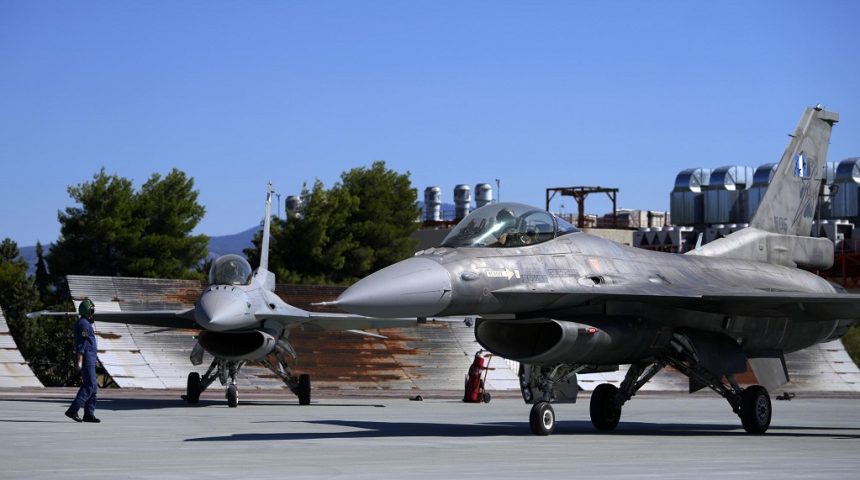The first two aircraft have been handed back after the upgrade and a test campaign in the United States.
The Hellenic Air Force took delivery of the first two fully upgraded F-16V Block 72 Viper fighter jets during a ceremony at Tanagra Air Base on Sept. 12, 2022. The aircraft are the first of 83 that will be upgraded from the Block 52+ to the latest standard, with the works being done locally by the Hellenic Aerospace Industries (HAI) at Tanagra, supported by Lockheed Martin.
The aircraft are the former F-16C Block 52+ with HAF serial 005 and 006 (USAF serial 06-0005 and 06-0006) which were acquired through the Peace Xenia IV Foreign Military Sales program in 2005 and delivered in 2009 to the 335 Mira Tigris (Tigers) and the 336 Mira Olympos (Olympus), respectively, at Araxos Air Base. The Viper 005 received the first part of the upgrades at Tanagra, where it flew again in January 2021, before it was transferred in the United States for the last upgrades and the certification of the work done by HAI, clearing them to proceed with the upgrade on other aircraft.
Παραλαβή από την ΕΑΒ των δύο πρώτων F-16 Viper από τα 83 συνολικά…@HAFspokesman @hndgspio @npanagioto pic.twitter.com/DbfZSojq0r
— Kostas Sarikas 🇬🇷 (@SarikasKostas) September 12, 2022
Παραλαβή των 2 Πρώτων Εκσυγχρονισμένων Αεροσκαφών F-16 Viper pic.twitter.com/YQ1vFibYoh
— Hellenic Air Force (@HAFspokesman) September 13, 2022
“Another very important day for the Air Force and the Armed Forces of the country, today, here at the EAB facilities in Tanagra, in the presence of the Ministers of Finance and Development and also in the presence of a group of Military Leadership, the delivery ceremony of the first two F -16 aircraft of the “Viper” version , the most modern F-16 aircraft currently in the world, took place from the ODA to the Air Force”, said the Minister of National Defense Nikolaos Panagiotopoulos. “This is an aircraft with enormous potential, especially in terms of its electronics, and will further increase its overall power.”
The electronics, in fact, is the main focus of the Block 70/72 upgrade. Among the new systems installed we can find the APG-83 AESA (Active Electronically Scanned Array) radar, a new Center Pedestal Display (CPD), the AN/APX-126 Advanced IFF (Identification Friend or Foe), Link 16 datalink, full NVIS (Night Vision Imaging System) and JHCMS II (Joint Helmet-Mounted Cueing System II) compatibility, a new Embedded GPS/INS (EGI), a modern commercial off-the-shelf (COTS)-based avionics subsystem, a high-volume, high-speed data bus and the Automatic Ground Collision Avoidance System (Auto GCAS).
Check out these amazing F-16 Vipers, powered with the best of American ingenuity.
The Viper upgrade enhances Greece’s defence capabilities and NATO interoperability, making the region more secure. 🇺🇸🇬🇷@Hellenic_MOD @hndgspio @HAFspokesman @LMEuropeNews @HAIcorp pic.twitter.com/zoq7rHNML1
— U.S. Embassy Athens (@USEmbassyAthens) September 12, 2022
“It is a true pleasure and honor for me to be here today to celebrate the next achievement in the Hellenic Air Force’s prized, and combat proven, F-16 program. Greece’s F-16 Vipers will immediately enhance NATO’s interoperability with 4th and 5th-generation fighter aircraft, ensuring our alliance can defend our security interests,” said the US Ambassador to Greece George J. Tsunis. “The U.S.-Greece defense cooperation is the strongest it has ever been. The Mutual Defense Cooperation Agreement framework has strengthened and advanced our common defense and strategic interests for more than three decades.”
The first two F-16s will be used for pilot training at Tanagra. The HAF expects between four to six more aircraft to be delivered by the end of the year, with the whole 83 scheduled to be completed by 2027. The head of Greece’s joint chiefs of staff, Gen. Constantinos Floros, said the program’s successful and timely completion “is an issue of the highest national importance.”
Oι Οχιές βγαίνουν απο την φωλιά!
Η Πολεμική Αεροπορία παραλαμβάνει σε λίγο τα πρώτα 2 αναβαθμισμένα F-16V από την ΕΑΒ, την πλέον προηγμένη έκδοση του μαχητικού Α/Φ!
(pic via @MyronGian) pic.twitter.com/TRdmBIwvUw
— e-Αmyna (@e_amyna) September 12, 2022
Today’s the day. pic.twitter.com/YrePI2IkL7
— Snips🇬🇷 (@Snips_99) September 12, 2022
Together with the F-16V upgrade, the HAF also opted to perform a subsequent in-house upgrade of the F-16C/Ds Block 50 by using equipment removed during the Block 72 upgrade from the other aircraft. With this upgrade the Block 50 Vipers will be reportedly brought to the to the M6 avionic configuration. In the meanwhile, reports emerged about a possible Letter of Request to be sent to the US for the upgrade of 38 F-16 Block 50 to the Block 70 configuration.
These 38 will be upgraded at Nea Anchialos Air Base instead of Tanagra, so both the Block 70 and Block 72 upgrades can proceed at the same time and without slowing down. According to the reports, the HAF intends to focus its F-16 fleet on the Block 70/72 Viper variant, the Block 52+ Advanced (also known as Block 52M) and the upgraded Block 50 variants, while the Block 30 jets will be used to train the pilots before they move to the more advanced variants.









